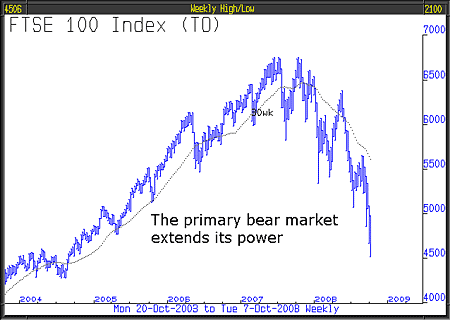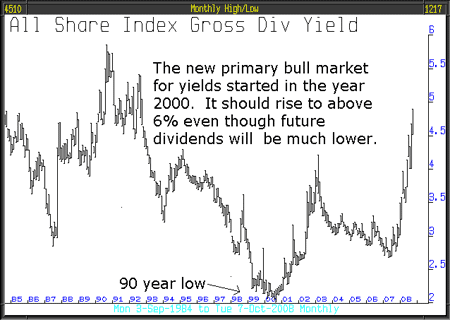The banking crisis could be just the start of our troubles
Downward trends in both the Dow Jones Industrial Average and the Dow Jones Transportation Average show that the banking crisis is just the start of our problems. Market performance could still get much worse.
The "Primary Bear Market" that started in the year 2000 and, in our view never ended, has unquestionably resumed as a result of the reversal of global liquidity. We are now embroiled in potentially the worst credit contraction of any readers' experience and the implications are alarming. Asset prices that specifically benefited from the preceding credit expansion will be the victims and will include most global equity markets, commercial and residential property and collectibles such as fine art and stamp collections. The duration is likely to be at least long enough to test the stock market lows set in March 2003 when the FTSE 100 was at 3278.
This paragraph was first published on 4th December 2007 and has been repeated in each issue since.
Our usual practice is to write this newsletter on Thursdays. Due to a business conference taking place on Thursday and Friday, this week we had to bring it forward to a day earlier, Wednesday 8th October.
MoneyWeek
Subscribe to MoneyWeek today and get your first six magazine issues absolutely FREE

Sign up to Money Morning
Don't miss the latest investment and personal finances news, market analysis, plus money-saving tips with our free twice-daily newsletter
Don't miss the latest investment and personal finances news, market analysis, plus money-saving tips with our free twice-daily newsletter
Any doubt that we are in a primary bear market for equities has now been eliminated as globally, stock markets continue to decline steeply.
When Congress finally approved Paulson's rescue plan and it became law, markets continued to decline. The banking crisis gets worse and the evidence grows that a severe economic global recession is unavoidable.




In the opening paragraph that has been repeated since 4th December 2007, we specifically identified; global equity markets, commercial and residential property and collectibles such as fine arts and stamp collections. So far, all but the collectibles have behaved as we expected. Now we read of a recent auction in Hong Kong at Sotheby's, of Chinese contemporary art where, according to the Wall Street Journal, bidders failed to buy top flight paintings when, at previous auctions, there had been fierce interest with prices often setting records. It was reported that, in this most recent auction, nineteen of forty-seven prominent works went unsold and others barely hit low estimates. This unfolding, dire, global recession takes no prisoners. All asset classes have much further to fall.
There have been two very important technical developments since last we wrote. The first concerns the yield gap. The yield gap is the difference between the UK stock market yield and the yield from 10-year UK gilts. Until the 1950s, the stock market dividend yield was invariably higher than the gilt yield. The rationale was that higher risk equity investors demanded a bigger yield for taking a greater risk. And then in the 1950s it all changed. Alastair Ross Goobey, the famous fund manager who managed the Imperial Tobacco company pension fund, said that if, in the future, pension funds were to deliver the promised benefits, at a time of rising inflation, they should own equities, not gilts. What followed was a long term change. Gilt yields rose dramatically, for example in 1981 they were above 16% and stock market yields were 6%. That was called the reverse yield gap'.
In March 2003 the yield gap closed; for a brief moment, intra-day, the 10-year gilt yield was the same as the All Share dividend yield, and then the stock market rallied and the reverse yield gap resumed. However it has now changed fundamentally, at the close of business Tuesday 7th October, the 10-year gilt yielded 4.48% and the All Share stock market index yielded 4.89%. The natural yield gap is back; from here it should widen dramatically as gilt yields fall on safe haven demand and stock market yields rise, as the equity markets collapse.
The post WWII low for the gilt yield was 2.5% in 1946 whilst the post WWII high for equity yields was 12% in 1975. We may be heading towards these extreme levels again.
Equity yields will rise considerably from here. Collapsing corporate earnings and corporate failures will significantly reduce the level of dividends paid. Only recently, the Financial Times warned stock market investors that they should brace themselves for steep cuts in dividend income this year.
The second technical development is from Dow Theory. Dow Theory says that when the Industrial and the Transport averages are in sync to the upside, then the outlook for equity markets and the economy is excellent; when they are in sync to the downside, the reverse.

Since the last issue, as can be seen by the charts, the Transports, which since 26th June 2008 had been seriously lagging, dramatically accelerated down, making a new 12-month low, matching the Industrials. It's as bleak an outlook as Dow Theory can deliver.


The return to the natural yield gap as equity yields go higher and gilt yields go lower, and the new primary bear market signal from Dow Theory gives significant technical support to the undeniable fact that the banking crisis is just the start of something that it is going to get much worse.
The SocGen Global Index Bear Accelerator is structured to specifically benefit from falling stock markets; unsurprisingly, it has gained considerably. We are currently discussing a new bear note to benefit from further stock market declines - as Kenneth Rogoff, Economics Professor at Harvard, recently said "The worst is to come".
Another essential ingredient is investor sentiment. It has soured. Like the Queen Mary, it takes a very long time to turn around again - until it does, no stock market recovery can be expected.
This article was written by John Robson & Andrew Selsby at Full Circle Asset Management,as published in the9 October edition of the threesixty Newsletter.
Get the latest financial news, insights and expert analysis from our award-winning MoneyWeek team, to help you understand what really matters when it comes to your finances.
MoneyWeek is written by a team of experienced and award-winning journalists, plus expert columnists. As well as daily digital news and features, MoneyWeek also publishes a weekly magazine, covering investing and personal finance. From share tips, pensions, gold to practical investment tips - we provide a round-up to help you make money and keep it.
-
 How cancelling unused direct debits could boost your pension by £37,000
How cancelling unused direct debits could boost your pension by £37,000A new year refresh of your spending could save you money and help boost your pension pot.
-
 NS&I cuts interest rates on 8 savings accounts
NS&I cuts interest rates on 8 savings accountsNS&I will now offer less attractive interest rates for customers wishing to lock their savings away to grow for one, two, three or five years.

